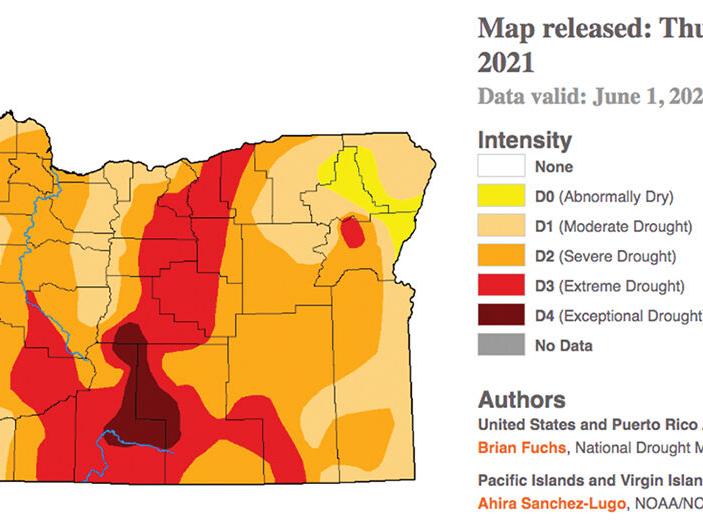
The following information was submitted in a news release from Oregon Department of Fish and Wildlife on June 2.
SALEM — March and April of 2021 were among the driest spring months since the 1890s. Many streams are already at 25% of the flow that is typical for this time of year, with flows usually seen in early summer observed in April on some southern Oregon streams
Oregon Department of Fish and Wildlife is bracing for a serious drought as summer arrives, with the entire state being impacted. Currently, 72% of the state is in severe or extreme drought status according to the U.S. Drought Monitor.
“Unfortunately, we are likely looking at a very tough summer and fall ahead for fish,” Shaun Clements, ODFW Deputy Administrator for Inland Fisheries. “It’s possible that ODFW may have to take emergency actions to protect native fish populations due to the drought.”
“Please try to be flexible with your fishing plans this summer as we get through this drought,” continued Clements. “Our weekly Recreation Report is the best source of information on conditions and any emergency regulation changes due to drought.”
Some of the emergency actions that could occur are:
• Trout stocking changes. The stocking schedule may change at short notice due to water conditions. Changes may not show up in the stocking schedule so see the Recreation Report for the latest information.
• Early release of fish: Low flows/high temps at hatcheries may force early release of salmon, steelhead and trout being raised.
• Emergency closures/regulation changes: Certain areas may be closed to angling to reduce stress on vulnerable fish populations already struggling due to drought; bag limits could be reduced or seasons shortened; “hoot owl” regulations may close fishing earlier in the day.
• Bag limits may be removed: In areas without sensitive fish populations, bag limits may be removed so surviving fish can be harvested rather than left to die in low water.
• Fish relocation: While rare, it’s possible ODFW will salvage fish and move them to a different waterbody.
Any regulation changes will be posted in the Recreation Report / Fishing Report by fishing zone, so recreationists are urged to always check the for the latest regulation change report before fishing.
On days when temperatures soar, anglers can do their part to reduce the stress fish are under by taking the following measures.
• Fish early in day when water temperatures are cooler.
• Look for trout in deep, high elevation lakes or shaded streams near headwaters. These places are often cooler.
• Use barbless hooks so you can release fish easily and land fish quickly. The longer the fight, the less likely the fish will survive if released.
• Keep the fish in the water when you unhook it and cradle the fish upright until it revives enough to swim away.
• Use your judgement. If conditions where you want to fish seems especially severe (low, hot water), consider fishing somewhere else where water conditions are better.
Due to climate change, droughts are expected to become more frequent and more severe. ODFW scientists are working to identify coldwater refuges, support flow restoration projects and improve habitat where possible to mitigate the effects of climate change on fish. For more information, see the agency’s climate change policy.
“There are things we can do to help ensure our iconic species can weather these droughts,” Clements said. “By protecting and restoring the most important habitats to provide cool, clean water, we give them a fighting chance.”
June 07, 2021 at 03:32AM
https://ift.tt/3x69o9p
Fish and wildlife officials brace for drought | Complimentary | argusobserver.com - Ontario Argus Observer
https://ift.tt/35JkYuc
Fish
No comments:
Post a Comment